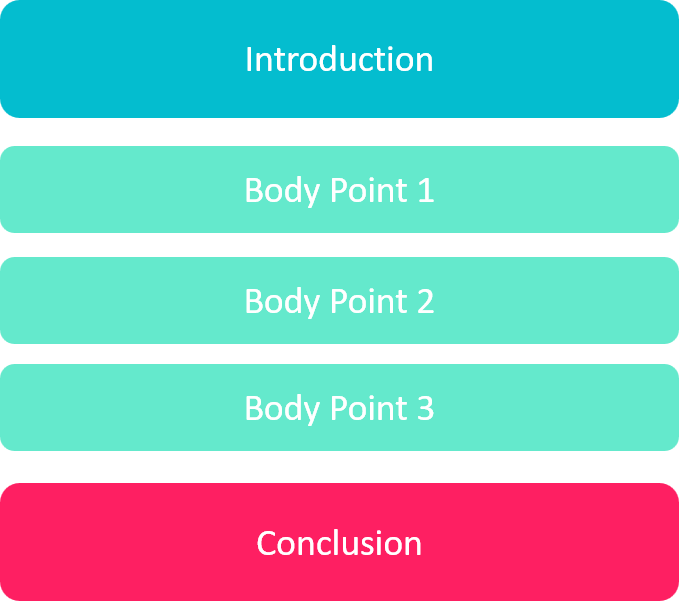Ending with a Call to Action

As a business English trainer, I often give my students presentations to do in class. Over time, I noticed that finishing a presentation seems to be hard for many people to do. After making the last point, my students would often say, “Um… okay, finished!” and sit down.
That’s clearly not the best way to finish a presentation! So, what is?
The answer is: a call to action.
But, before that, let’s review what a simple presentation looks like from the top-down:

Notice that this simple presentation structure looks like a school essay! You introduce your topics, make your points and conclude your talk. It’s suitable for a talk on three upcoming projects that your department is working on, for example.
You could finish this talk by summarizing your three main points. It’s a good enough way to finish, but it lacks impact.
A better way is to use a call to action. To tell your audience what you want them to do next. (Note that your conclusion can include a summary AND a call to action.)
Here are some examples of calls to action that you may have at the end of a business presentation:
- Approve an idea
- Invest in a product or scheme
- Make a donation
- Sign up to a program
- Arrange a meeting to move a project forward
- Make a change to the way you do things (e.g. take steps to reduce your carbon footprint)
As an example, imagine Juan has just presented to the management on the issues with his company’s customer service. Here is his call to action:
I’m sure you all agree that these are serious issues that can affect our company’s bottom line. But what can we do about it?
I’m asking you to allow me to form an internal training department, separate and distinct from Human Resources. Please consider this very carefully and if you give the green light to move forward, I will draw up a budget and action plan for you to approve.
Can you see how powerful Juan’s call to action is? Rather than simply add a conclusion to the end of his presentation, his entire presentation was leading up to the action that he wanted the management to take.
This is why you should never forget the conclusion of your talk – it’s often the most important part. Here’s a pro tip: if you’re using PowerPoint, make sure that you include your call to action in your final slide (instead of ending with a Thank You slide).
Examples
TED talks are great places to get presentation tips, so let’s see three examples of calls to action.
Example 1
Luisa Neubauer is passionate about the environment and gives a talk about the "fairy tales" of the fossil fuel industry. She ends by calling on everyone to change their lives and "build a new tomorrow".
So this is a call for the people everywhere, for the normal people to stop their normal lives and start beginning to build a new tomorrow so that at some point we can have a new normal again. That new tomorrow, it won't be built for those who have brought us into this entire mess, whom we have no reason to trust and who wish to sit at the same table as we do, but will never sit at our side. It will be built for everyone else. It will put people over profits and lives over fossil fuels. It will be just, and it will be safe after all. So I'd say, let's get to work.
Luisa’s full talk can be found here:
Example 2
Matt Cutts gives a talk on 30-day challenges that can change your life. Although he is telling a story about his own experiences, he still ends with a call to action – a challenge to the audience to also try a 30-day challenge:
So here's my question to you: What are you waiting for? I guarantee you the next 30 days are going to pass whether you like it or not, so why not think about something you have always wanted to try and give it a shot for the next 30 days!
Matt’s full talk can be found here:
https://www.ted.com/talks/matt_cutts_try_something_new_for_30_days
Example 3
Graham Hill argues that you will be happier if you live in a smaller house and own fewer things. His call to action asks the audience to consider “editing” their lives to do this.
So I'm not saying that we all need to live in 420 sq. ft. But consider the benefits of an edited life. Go from 3,000 to 2,000, from 1,500 to 1,000. Most of us, maybe all of us, are here pretty happily for a bunch of days with a couple of bags, maybe a small space, a hotel room. So ,when you go home and you walk through your front door, take a second and ask yourselves, "Could I do with a little life editing? Would that give me a little more freedom? Maybe a little more time?"
Graham’s full talk can be found here:
https://www.ted.com/talks/graham_hill_less_stuff_more_happiness
Language
The language that we use for a call to action is very simple and there are many sentence structures we can use:
I suggest that…
What I want you to do is…
I’d like you to try…
Why don’t you…
Please consider…
Give it a shot!
If you’re interested, the next step is…
We can also use imperatives (direct commands). These either begin with a verb or begin with ‘don’t’ in the negative form:
Try it today!
Sign up as soon as you can.
Invest in our project.
Don’t wait!
Don’t miss out.
Sometimes, we put PLEASE before the verb:
Please think carefully about this
Please don't waste your money on scam investments.
You can find some examples of imperatives in the three examples that we covered.
Let me end with my own call to action: Make sure that you include a call to action in the next presentation that you give!

Test Yourself
1 Where do we usually find a call to action in a presentation?
2 An example of a call to action is:
3 Which sentence is grammatically correct for a call to action?
4 Which of these is an imperative?